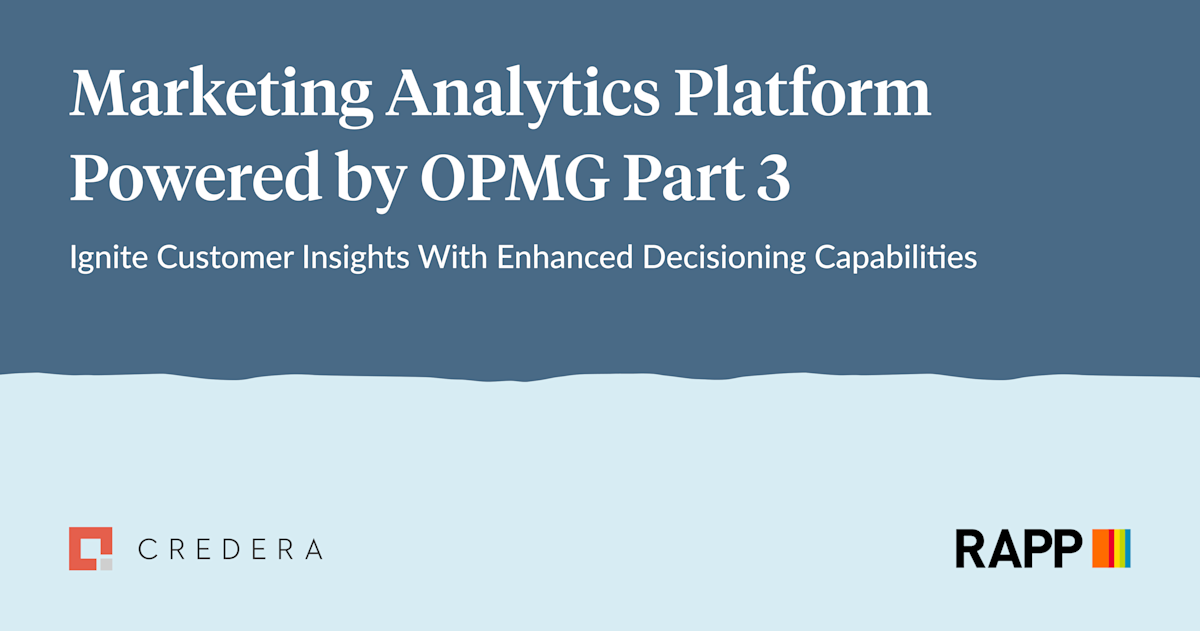Technology
Mar 30, 2022
Marketing Analytics Platform Powered by OPMG Part 3: Ignite Customer Insights With Enhanced Decisioning Capabilities

Is your platform generating data or generating value? Companies have made significant investments in collecting and storing large amounts of first-party data routinely used for rear-view mirror reporting and dashboard visualizations. Although this is helpful, we’d like to share how you can take that wealth of data to the next level by enhancing decisioning and predictive journey analytics through a marketing analytics platform (MAP).
In part one of this series, we introduced four steps to harness the value of customer data. In part two, we shared how modern cloud data platforms enable marketers to accelerate value to deliver differentiated precision marketing. In this installment, we will dive deep into enhancing decisioning.
What Is a Decisioning Engine?
Before diving into how MAPs can improve decisioning, it is important to understand what a decisioning engine is. A decisioning engine is an automation platform that can either execute static rule sets and/or use artificial intelligence (AI) models to predict the next best action for a user based on a combination of first- and third-party data.
Decisioning engines, such as Pega Customer Decision Hub, play an important role in activating on your data, and they rely heavily on the quality of data and its aggregation, which is where a MAP fits in.
What Is a Marketing Analytics Platform?
A MAP supplements an existing decisioning engine by enriching data with third-party sources and adding propensity data to enhance real-time data modeling capabilities. This allows companies to collect and connect data from a variety of sources and provide cleaner reporting, stronger analysis, and more advanced modeling.
How Does a Marketing Analytics Platform Enable Decisioning Use Cases More Effectively?
One of the many advantages of a marketing analytics platform is that multiple first- and third-party data sources are ingested, cleansed, and transformed into a standard data model and further enriched through sophisticated identity resolution platforms, providing a rich set of data attributes that can be mined for creating powerful propensity models. More importantly, this data is democratized throughout the enterprise, allowing others to use it as a data source for exploratory data analysis, modeling, and visualization.
To summarize, the key benefit for using a marketing analytics platform to enable a decisioning engine is high quality data ingestion and the ability to create and leverage external machine learning (ML) models that elevate the decisioning engine beyond if-then-style rules.
What Are Some Specific Decisioning Use Cases Where a MAP Can Add Value?
It is helpful to establish high-level use case categories to identify specific opportunities for decisioning. We have outlined some primary use case categories below.
Common Use Case Categories for Decisioning:
Customer acquisition: Strategically directing a prospective customer along the path to purchase.
Customer retention: Strategically directing a current customer along the path to passion.
Pricing and promotions: Marketing campaigns focused on conversion through strategic communication and discounts.
Products: Marketing campaigns focused on target markets and value propositions.
As you read the following decisioning use cases, look for the conditions that trigger different actions and consider how a MAP could elevate the standard capabilities of a decisioning engine.
Pricing and promotions: In the telecommunications industry, deliver personalized discounts to move excess or new inventory for customers with dated devices.
But with a MAP…
Leverage inventory data, historical customer account data, and real-time customer behavior data to create a propensity model that can identify the right discount to send to each customer based on their specific plan or device.
Products: In the healthcare industry, reduce hospitalization rates through educational messages promoting covered costs such as well visits, flu shots, cholesterol screenings, etc.
But with a MAP…
Enrich the customer profile with additional attributes for the decision engine to determine the best message to be delivered to in-need patients.
Customer acquisition: In the insurance industry, proactively re-solicit quotes not taken with relevant completion offers.
But with a MAP�…
Enrich the customer profile with third-party data to develop a proprietary model that appends propensity scoring for completion of offer with tailored discounts.
Pricing and promotions: In retail, abandon cart messages or display advertisements are a common example where the intelligence on when to send the reminder and whether to include an additional discount can be developed.
But with a MAP…
Enrich customer profiles with third-party data to develop a proprietary model that appends propensity scoring for completion of offer with tailored messaging and discounts.
Technically, How Is It Done?
The following diagram provides a high-level view of a MAP using Amazon Web Services.

You can find an in-depth guide to setting this up in multiple cloud environments in the following blog article.
What Does This Added Value Look Like in Real Life?
To bring this back, let’s dive into one of the use cases from above. Imagine you are an insurance provider looking to deliver triggered, personalized notification of potential risks and you recognize a MAP can enable you to incorporate external weather data to provide real-time relevant communications to at-risk policy holders.
To further explain how a MAP works with a decisioning engine, we will use Pega Customer Decision Hub (CDH) to highlight the integration process with Amazon Web Service analytics platform, as seen above. There are three common integrations we employ with Pega:
Pega Customer Decision Hub and Marketing Analytics Platform
Data integration: Send data directly to Pega CDH through APIs or data feeds where Pega will consume the data and its models will use it as input for its insights and next best action.
Model import: Export custom models created in a MAP using R or Python as a PMML file that can be imported into Pega, which can be used for decision strategies.
Model integration: Employ machine learning as a service where a model can be created within the MAP environment and hosted using a machine learning platform such as Amazon Sagemaker.
What Are the Implementation Details for Each Integration Option?
Option 1: Data Integration
Returning to our insurance example, you recognize you need to supplement your first-party data with third-party weather data. Pega supports data ingestion through batch files but expects specific formats for data integration. Whether it is CSV or JSON data files, manifest files, or token files, a MAP can automatically create these as a part of a data pipeline.
A MAP can make the process of creating data and manifest files efficient, including enabling automation and anamoly detection. This is crucial because the quality of decisioning provided by the Pega platform is dependent on the quality of data that is fed into the platform and a MAP can ensure high quality data feed with little to no human intervention. When considering the importance of timeliness with inclement weather notifications, trusting the automation of your data and decisioning is vital.
Option 2: Model Import – Custom Modeling
Beyond enriching your data, introducing custom models to your Pega Customer Decision Hub through a MAP can ensure your communications to at-risk customers are timely and relevant. In our insurance example, the team could train a custom ML model that predicts the likelihood that a given weather event will cause damage to specific types of property (car, home, boat, etc.) and use this to send targeted alerts. Machine learning models developed using R and Python can be exported as PMML files, with the MLOps components of a MAP helping automate the creation of the PMML artifacts to make the integration seamless. Pega can ingest these custom machine learning models as exports using the Pega Prediction Studio.
The PMML file can then be imported into Pega as Pega Predictive model, which can then be utilized in Decision Strategies. Here is a step-by-step process of how to do this:
Log in to Pega Prediction Studio.
Import an ML model (in PMML or H20 MOJO format) using Pega Prediction Studio.
After importing the model, the expected performance of the model, which is measured as area under curve (AUC), can be set to a value between 50-100.
The predictors are mapped automatically to the Pega data model for the predictors having a name match. The other predictor properties will need to be created in Pega before the model can be used.
Models can then be used in Pega Decision Strategies using the predictive model shape as shown below.
Option 3: Model Integration – Machine Learning as a Service
A more recent iteration of the modeling approach is to expose machine learning models as a service. The advantage to this approach is that the model can respond to inputs in real time and can provide the most up to date decisioning model to the engine at the time the decision is requested. This would enable our Insurance Model to be independently updated by the Data Science team, for instance to take advantage of additional data points like the make and model of the car to send targeted messages. By leveraging the Amazon SageMaker machine learning platform as a part of the MAP, Pega can leverage these custom machine learning models using the Pega Prediction Studio.
Pega Predictive model can connect directly to Amazon SageMaker to be utilized in Decision Strategies. Here is a step-by-step process of how to do this:
Log in to Pega Prediction Studio.
Add the authentification profile of the model as a service you are trying to connect.
Name the model to complete the connection.
Bringing It All Together
Decision engines play a crucial role in activating on your data and creating a positive, meaningful experience for your customers. As customer expectations for your company’s interactions increase, having confidence that you can deliver tailored experiences in real time is more important than ever.
Using a marketing analytics platform to enrich your data and improve your decision modeling can enable you to anticipate customer needs and proactively engage with them in a meaningful way at every step of their journey. With a combination of Pega’s Customer Decision Hub and Amazon’s Web Service analytics platform, you can ensure your platforms are generating value with their data.
Up Next in Our Marketing Analytics Platform Series
This is part three of a multi-part series exploring how a single customer view powered by Tealium and AWS can help you provide personalized customer experiences and increase the ROI of your marketing budget.
In part one, we introduced four steps to harness the value of customer data: unifying data, segmenting customers, orchestrating experiences, and measuring the journey.
In part two, we shared how modern cloud data platforms, specifically marketing data platforms, enable marketers to accelerate these four steps and deliver differentiated precision marketing.
Interested in learning more about how Credera can help your company deliver personalized omnichannel experiences by enabling a single customer view? Reach out to one of our MarTech experts at marketing@credera.comto get the conversation started.
Marketing Analytics Platform Powered by OPMG
OPMG’s Marketing Analytics Platform (MAP) is a technology toolkit for marketing teams to unlock value from their customer data. The toolkit blends enterprise patterns, cloud technology, and off-the-shelf software to unify customer data, segment customers, orchestrate real-time experiences, and measure the customer journey.
This content was created in a partnership between RAPP and Credera, sister agencies and part of Omnicom Precision Marketing Group (OPMG). Omnicom Precision Marketing Group aligns Omnicom's global digital, data, and customer relationship management capabilities to deliver precisely targeted and meaningful customer experiences at scale.
Contact Us
Let's talk!
We're ready to help turn your biggest challenges into your biggest advantages.
Searching for a new career?
View job openings









